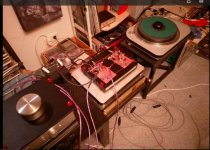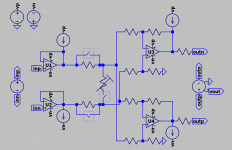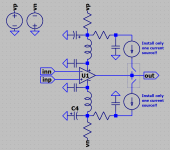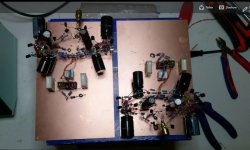what are q19-q22 doing, if I may ask? thermal compensation?
And Q20, Q21
I have the prototype playing in my system !
I am surprised that it was such an easy build. It worked right away after eroding some little bugs.
Hum is more or less non existent when i earthed correctly.
This version has an INA at the output to do the Bal-Unbal conversion. The only " special " thing i did is the way i biased the input of the INA. It is like Bruno did in in the Linear Audio preamp.
Set up this way hiss is lower then in the version i published before.
Frans has an idea how to improve on the INA and keep the low noise.
The sounds seems fine too. The main thing that i noticed is that the bass is very potent.
That can be my implementation of the RIAA that has a little bass lift, maybe 0.5dB.
I did not have the excat values at hand that Frans calculated.
A little left turn on the Subs volume solved that issue.
A question came up if we can make the gain adjustable. What i whould really like to do is some kind of volume control that has Bal and Unbal out. Then we have a stand alone unit for all purposes that does not need a preamp. The volume control could also be used to EQ volume diffences in the cartridge if there are any.
I am surprised that it was such an easy build. It worked right away after eroding some little bugs.
Hum is more or less non existent when i earthed correctly.
This version has an INA at the output to do the Bal-Unbal conversion. The only " special " thing i did is the way i biased the input of the INA. It is like Bruno did in in the Linear Audio preamp.
Set up this way hiss is lower then in the version i published before.
Frans has an idea how to improve on the INA and keep the low noise.
The sounds seems fine too. The main thing that i noticed is that the bass is very potent.
That can be my implementation of the RIAA that has a little bass lift, maybe 0.5dB.
I did not have the excat values at hand that Frans calculated.
A little left turn on the Subs volume solved that issue.
A question came up if we can make the gain adjustable. What i whould really like to do is some kind of volume control that has Bal and Unbal out. Then we have a stand alone unit for all purposes that does not need a preamp. The volume control could also be used to EQ volume diffences in the cartridge if there are any.
Attachments
HI,
if You use a ´3-OPAmp´ INA (unbalanced out) its easy to vary gain with a single resistor between the inverting inputs of the INA´s two input OPAmps.
To generate balanced outputs I´d use two INAs in parallel (the second just with its inputs crossed).
Then a Dual-pot or pairs of discrete resistors would allow to vary the gain.
Feeding the ref-inputs of the 3rd OPAmps of the INAs would allow to DC-servo the INAs.
jauu
Calvin
if You use a ´3-OPAmp´ INA (unbalanced out) its easy to vary gain with a single resistor between the inverting inputs of the INA´s two input OPAmps.
To generate balanced outputs I´d use two INAs in parallel (the second just with its inputs crossed).
Then a Dual-pot or pairs of discrete resistors would allow to vary the gain.
Feeding the ref-inputs of the 3rd OPAmps of the INAs would allow to DC-servo the INAs.
jauu
Calvin
HI,
if You use a ´3-OPAmp´ INA (unbalanced out) its easy to vary gain with a single resistor between the inverting inputs of the INA´s two input OPAmps.
To generate balanced outputs I´d use two INAs in parallel (the second just with its inputs crossed).
Then a Dual-pot or pairs of discrete resistors would allow to vary the gain.
Feeding the ref-inputs of the 3rd OPAmps of the INAs would allow to DC-servo the INAs.
jauu
Calvin
But we will not
Maximum Amplifier Decoupling
First of all, I need to apologize, the project is not moving forward as speedy as should be, but I do promise you (all), we will get there
The project will be using 4 opamps, and they will be deployed in a technologie that I will call (from now on) "Maximum Amplifier Decoupling" or short MAD(c).
Each opamp will be placed on it's own board, the board will contain independent PSU filtering for each opamp and also will prevent 'back-flow' of signal from one to the other(s) opamp(s). All higher impedance circuitry will be contained (and limited) to these board(s) to minimize crosstalk between the opams, balanced (+ to - side) and foreward (previous to next, and or, next to previous opamp(s)). These boards will have a ground plane for (one of the) the same reason.
First of all, I need to apologize, the project is not moving forward as speedy as should be, but I do promise you (all), we will get there
The project will be using 4 opamps, and they will be deployed in a technologie that I will call (from now on) "Maximum Amplifier Decoupling" or short MAD(c).
Each opamp will be placed on it's own board, the board will contain independent PSU filtering for each opamp and also will prevent 'back-flow' of signal from one to the other(s) opamp(s). All higher impedance circuitry will be contained (and limited) to these board(s) to minimize crosstalk between the opams, balanced (+ to - side) and foreward (previous to next, and or, next to previous opamp(s)). These boards will have a ground plane for (one of the) the same reason.
Last edited:
MADThe project will be using 4 opamps, and they will be deployed in a technologie that I will call (from now on) "Maximum Amplifier Decoupling" or short MAD(c).
I am... IN
The Paradise can be build in many ways. The best of them sounded very, very good.
The main diffenence to the Zion is that the Zion is balanced and the input stage has a DC coupled bias. Both implemented because of request from the comunity.
The Zion prototype i build works well too. As i said, it has a very dynamic and slamming bass. When the Zion is ready we will make a comparison to a full monty Paradise.
That will be fun.
The main diffenence to the Zion is that the Zion is balanced and the input stage has a DC coupled bias. Both implemented because of request from the comunity.
The Zion prototype i build works well too. As i said, it has a very dynamic and slamming bass. When the Zion is ready we will make a comparison to a full monty Paradise.
That will be fun.
The Zion will be a modular build, out of building blocks that can be used for other audio projects. The psu is build from 2 modules, the gain and buffer stage are an other (reusable) module, and the cartridge-amp will be integrated on a (type of) bus-board. I'm still figuring out if it is possible to place the RIAA components on a separate (replaceable/updatable/improvable) plug-board.
At the moment I am running test's on the psu and amplification/buffer boards (these are my 'alpha' boards).
While I do that, Joachim has build a spider-web prototype that sound ...
Before we release anything we want to iron out all bugs and yes we will have it ready before x-mas (i think), so go and write your letters to Santa.
and yes we will have it ready before x-mas (i think), so go and write your letters to Santa.
At the moment I am running test's on the psu and amplification/buffer boards (these are my 'alpha' boards).
While I do that, Joachim has build a spider-web prototype that sound ...
Before we release anything we want to iron out all bugs
Last edited:
The Zion will be a modular build,. The psu is build from 2 modules,
Being able to use the Paradise PSU would be cool.

- Status
- This old topic is closed. If you want to reopen this topic, contact a moderator using the "Report Post" button.
- Home
- Vendor's Bazaar
- Zion, a ready made Phono Stage by the Paradise team





